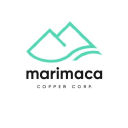Marimaca Copper: Building a High-Margin, Tier-1 Copper Producer in Chile's Prolific Coastal Belt
.jpg)
Marimaca Copper advances Chile oxide project with strong economics, low capital intensity, environmental approval, and district growth potential in tight copper market.
- Environmental Approval Secured: Marimaca received formal RCA approval in November 2025, fast-tracking the permitting pathway and de-risking the construction timeline for the Marimaca Oxide Deposit.
- Robust Project Economics: The 2025 DFS delivered a post-tax NPV₈% of US$1.1 billion at current copper prices, with 39% IRR, 2.2-year payback, and industry-leading capital intensity of US$11,700 per tonne of copper production capacity.
- High-Margin Production Profile: The MOD targets steady-state production of 50 ktpa copper cathode over a 13-year mine life, with C1 cash costs of US$1.69/lb and second-quartile AISC of US$2.09/lb.
- District-Scale Exploration Upside: Complementary oxide resources at Pampa Medina and Madrugador, plus emerging sulphide potential, offer pathways to production expansion and mine-life extension.
- Strategic Location and ESG Leadership: The project sits 25 km from the Port of Mejillones, with access to recycled seawater, renewable power, and a skilled local workforce, supporting low-carbon copper production.
Introduction
Marimaca Copper Corp. (TSX: MARI, ASX: MC2) is developing one of Chile's most advanced copper oxide projects in the heart of the Coastal Copper Belt, a prolific metallogenic district that has produced copper for over a century. With the Marimaca Oxide Deposit now backed by a definitive feasibility study and key environmental approval in hand, the company is on track to become a near-term copper producer. For investors seeking exposure to copper's structural supply-demand imbalance, Marimaca offers a rare combination: low execution risk, high margins, and district-scale growth potential.
The November 2025 receipt of the Resolución de Calificación Ambiental represents the culmination of multiple years of baseline studies, voluntary stakeholder engagement, and rigorous regulatory review. This achievement positions Marimaca as one of the few fully permitted copper development projects globally, with a clear pathway to Final Investment Decision in H2 2026. The company's strategy balances near-term production with systematic exploration across its 27,000-hectare land package, offering investors both cash flow visibility and resource growth optionality.
This article examines why Marimaca Copper warrants investor attention, drawing on the company's November 2025 corporate presentation and recent DFS results. We assess the project's technical fundamentals, financial returns, exploration upside, and strategic positioning in a tightening copper market where new supply remains scarce and capital intensity continues to climb across the sector.
Company Overview
Marimaca Copper was founded to consolidate and develop copper assets in northern Chile's Antofagasta region, an area home to major mines including Mantos Blancos, Lomas Bayas, and Spence. The company's flagship Marimaca Oxide Deposit contains 213.5 million tonnes of Measured and Indicated resources at 0.40% CuT for 854 thousand tonnes of contained copper, with 93% of total resource tonnes now classified in the M&I category. The deposit's oxide mineralisation is amenable to heap leach processing, a lower-cost extraction method suited to Marimaca's shallow, high-grade blanket mineralisation style that has proven successful across Chile's coastal belt.
The company's board and management team bring deep experience in Chilean copper development and operations. The team includes co-founders of First Quantum Minerals, former executives from Mantos Copper and Capstone Copper, and specialists in exploration geology and project execution. This expertise is reflected in the systematic approach to resource development, permitting strategy, and stakeholder engagement that has characterized Marimaca's advancement from discovery to feasibility stage over the past several years.
Marimaca's strategy is two-pronged: advance the MOD to production while systematically expanding the resource base through exploration of complementary oxide and sulphide targets across the broader district. This dual approach positions the company to deliver near-term cash flow while building a pipeline for production growth beyond the initial 13-year mine life contemplated in the current feasibility study.
The Marimaca Oxide Deposit: Project Fundamentals
The 2025 Mineral Resource Estimate for the MOD reports 103.3 million tonnes Measured at 0.45% CuT containing 466 thousand tonnes of copper, plus 110.1 million tonnes Indicated at 0.35% CuT containing 387 thousand tonnes of copper. An additional 21.2 million tonnes of Inferred resources at 0.29% CuT contain 62 thousand tonnes of copper. This resource base reflects continuous drilling programs since 2017 that have systematically converted Inferred material into higher-confidence categories while expanding the known extent of mineralisation both along strike and at depth.
Of the total Measured and Indicated resource, 88% was successfully converted into Proved and Probable reserves in the 2025 DFS. The reserve statement comprises 94.3 million tonnes Proved at 0.46% CuT for 433 thousand tonnes of contained copper, and 84.3 million tonnes Probable at 0.37% CuT for 314 thousand tonnes of contained copper, totaling 178.6 million tonnes at 0.42% CuT for 748 thousand tonnes of contained copper. This high conversion rate demonstrates the geological continuity and predictability of the oxide blanket, reducing technical risk for investors evaluating the project's development potential.
The reserve base supports a 13-year mine life with an average life-of-mine strip ratio of 0.8:1, including pre-stripped material. The first four years of mining average a particularly attractive strip ratio of 0.6:1, frontloading higher-grade material and supporting rapid payback. The mine design contemplates an eight-phase pit sequence engineered to deliver consistent ore feed to the processing facility while optimizing pit slope angles that range from 37 to 45 degrees based on detailed geotechnical domain modeling completed during the feasibility study.
Mine Design & Processing
The MOD will be developed as a conventional open-pit operation utilizing 220-tonne haul trucks and 29-cubic-meter hydraulic shovels in a truck-and-shovel configuration proven across Chilean copper operations. Initial production capacity is set at 25 million tonnes per annum, expanding to peak production of 35 million tonnes per annum in year four to facilitate a crusher expansion in year six. The mining fleet will scale from seven haul trucks initially to 13 by year seven, with all ancillary equipment requirements fully integrated into the capital cost estimate and mine schedule.
Ore will be processed through a three-stage crushing circuit to achieve P80 passing 12.5mm, then agglomerated with sulfuric acid applied at variable doses based on mineral subdomain characteristics identified through the geometallurgical model. Crushed and agglomerated ore will be stacked on 4-meter-high dynamic heap leach pads using conveyor systems, with initial construction of 12 heap leach cells sufficient for the first phase of operations. The crushing circuit has been deliberately oversized in the initial design to accommodate cost-effective expansion in year six, minimizing future capital requirements for throughput growth.
The heap leach process involves irrigating stacked ore with 10 grams per liter sulfuric acid solution and seawater at a maximum rate of 10 liters per hour per square meter. Two-phase irrigation time ranges from 62 to 83 days depending on mineral subdomain, with pregnant leach solution advancing to a solvent extraction and electrowinning facility designed for nominal production of 50,000 tonnes per annum of copper cathode. The SX-EW plant features a three-stage solvent extraction configuration with one stripping stage and two washing stages, feeding a 142-cell electrowinning plant that will produce LME Grade-A copper cathodes for sale into global markets.
Financial Performance & Project Economics
The MOD's initial capital cost totals US$587 million, comprising US$437 million in direct costs representing 74% of the total, US$80 million in indirect costs at 14%, US$17 million in owner's costs at 3%, and US$53 million in contingency at 9% of direct and indirect costs combined. Budget quotes have been obtained for 80% of mechanical equipment, significantly de-risking the capital estimate, which falls within AACE Class 3 guidelines with expected accuracy of negative 20% to positive 25%. Total life-of-mine capital expenditure including sustaining and expansion capital is projected at US$1.2 billion over the 13-year mine life.
This capital structure translates to a capital intensity of US$11,700 per tonne of annual copper production capacity, ranking the MOD among the lowest capital intensity copper development projects globally when compared against North and South American peers. For context, other development projects in the region show capital intensity ranging from US$13,400 to US$21,800 per tonne of production capacity, positioning Marimaca as a clear outlier in terms of capital efficiency. The low capital intensity reflects the project's shallow oxide mineralisation, proximity to infrastructure, lack of requirements for onsite accommodation, and conventional processing technology that avoids the complexity and cost of flotation circuits or concentrate handling.
Operating cost fundamentals are equally compelling. Steady-state C1 cash costs are projected at US$1.69 per pound, rising to US$1.84 per pound on a life-of-mine basis that includes lower-grade material in later years. All-in sustaining costs stand at US$2.09 per pound in steady state (years 2 through 10) and US$2.29 per pound life-of-mine, placing the MOD firmly in the second quartile of the global copper cost curve. These costs are supported by competitive mining costs of US$2.00 per tonne, efficient heap leach processing at US$6.25 per tonne, minimal general and administrative costs of US$0.25 per tonne given the lack of camp requirements, and short transport distances to port facilities for sulfuric acid procurement and cathode shipping.
Investment Returns & Sensitivity
At a long-term copper price of US$4.30 per pound, the 2025 DFS delivers post-tax NPV at 8% discount rate of US$709 million, post-tax IRR of 31%, and payback period of 2.5 years. At the three-month average COMEX spot price of US$5.05 per pound prevailing at the time of the DFS publication, these returns improve sharply to post-tax NPV8% of US$1.1 billion, post-tax IRR of 39%, and payback period of 2.2 years. Average annual EBITDA over the first ten years of operation is US$241 million, with peak EBITDA of US$335 million projected in year four when mining hits optimal strip ratios and processing achieves steady-state throughput.
Post-tax free cash flow generation is equally robust, with average annual free cash flow of US$160 million during operating years, supporting both debt service capacity and potential shareholder returns. The first five years of steady-state operations (years 2 through 6) generate average annual EBITDA of US$326 million and average annual free cash flow of US$222 million, frontloading cash generation and reducing financing risk. This strong early cash flow profile is attributable to the low strip ratio in the initial mining phases, higher-grade oxide material in the near-surface blanket, and rapid ramp-up to full production within the first year following commissioning.
Sensitivity analysis demonstrates that the project's economics remain robust across a range of commodity price and cost scenarios. A 10% increase in copper price lifts the IRR from 31% to 37%, while a 10% decrease in copper price reduces IRR to 26%, still well above typical mining hurdle rates. On the cost side, a 10% increase in operating costs reduces IRR to 28%, while a 10% reduction improves IRR to 34%. Capital cost sensitivity shows similar resilience, with a 20% capital overrun reducing IRR to 24% and a 20% capital underrun increasing IRR to 37%. This sensitivity profile reflects the project's strong margin structure and the leverage that low capital intensity provides to investor returns.
Environmental & Social Approval
In November 2025, Marimaca received formal approval of its Environmental Impact Declaration, known in Chile as the Resolución de Calificación Ambiental. According to the company's announcement, this "marks the formal approval of the Company's DIA submission made in December 2024" and represents a "significant de-risking milestone" as it "marks another strategic step closer to being construction-ready at the MOD." The RCA is the key environmental permit required for project construction in Chile and typically represents the most significant regulatory hurdle for mining projects given the comprehensive review process and public consultation requirements.
The DIA submission was supported by multiple years of environmental baseline studies covering air quality, water resources, biodiversity, archaeological resources, and social impacts. The company conducted voluntary stakeholder engagement sessions with local communities, regional authorities, and indigenous groups well in advance of the formal submission, building relationships and addressing concerns proactively rather than reactively. This preparation work contributed to a smooth review process and timely approval, contrasting with projects that face extended timelines or conditions due to inadequate stakeholder engagement or baseline characterization.
Marimaca is now advancing its Sectorial Permits, which are auxiliary permits required for specific construction and operational activities such as water extraction, waste management, explosives handling, and transportation. The company notes:
"It is well advanced in its next phase of permitting activities and remains on track for a Final Investment Decision in H2 2026."
The RCA approval removes the largest single permitting risk from the project timeline and provides investors with confidence that environmental and social considerations have been appropriately addressed through Chile's established regulatory framework.
Operational Advantages & Infrastructure Access
The MOD is located 25 km from the Port of Mejillones and 40 km from Antofagasta, the regional capital with a population exceeding 400,000 and an international airport with direct connections to Santiago and other major cities. This proximity to first-class infrastructure delivers multiple operational and cost advantages that are reflected in the project's competitive economics. A water option agreement has been secured for recycled seawater from the Bay of Mejillones, with a 32 km pipeline designed for 208 liters per second capacity. The use of recycled seawater eliminates the need for continental or fresh water resources, addressing a key environmental concern in Chile's arid northern region and differentiating Marimaca from projects that face water scarcity constraints.
Certified renewable electricity is available from Chile's national grid through a short spur connection to the project site, eliminating the need for onsite power generation and supporting Marimaca's commitment to low-carbon copper production. The company has stated it is "targeting industry-leading low-carbon emissions" and notes that "heap leaching is 38% less carbon intensive than traditional processing" methods such as flotation and smelting. Access to renewable power and the inherent efficiency of the heap leach flowsheet position Marimaca to produce copper cathodes with carbon intensity in the first quartile of global copper mine site emissions, a meaningful advantage as institutional investors and copper consumers increasingly prioritize sustainably produced metals.
Transportation infrastructure is equally advantageous. The project is accessible via Route 1, Chile's main north-south highway, with the Port of Mejillones providing access to sulfuric acid supply from regional smelters and export facilities for finished copper cathodes. The short truck haul from mine to port reduces logistics costs and transit time compared to interior projects that require longer road or rail transport to reach tidewater. The project's altitude of 1,100 meters above sea level is significantly lower than many Andean copper mines, reducing the operational challenges associated with high-altitude mining such as equipment performance degradation, worker health impacts, and weather-related disruptions.
Green Copper & ESG Leadership
Marimaca is positioning the MOD as a "green copper" project with leading environmental, social, and governance credentials that align with institutional investor mandates and the growing demand for sustainably produced metals. The project's environmental footprint is minimized through several design features. No fresh water will be consumed in operations, with 100% of process water supplied by recycled seawater from desalination reject streams at the Bay of Mejillones. Certified renewable electricity will supply 100% of power requirements, eliminating Scope 2 carbon emissions associated with fossil fuel-based grid electricity. The heap leach processing route produces 38% less carbon dioxide equivalent emissions per tonne of copper than conventional flotation-smelting routes, supporting low Scope 1 and Scope 2 carbon intensity.
Social considerations have been carefully managed throughout project development. The MOD has no overlap with community lands, eliminating displacement concerns and simplifying the land acquisition process. The local workforce in Antofagasta has extensive mining experience given the concentration of copper operations in the region, and the absence of onsite accommodation requirements means workers can commute from existing communities, supporting local employment and reducing the social footprint of the operation. The company has conducted extensive voluntary stakeholder engagement throughout the development process, building relationships with local communities, regional authorities, and indigenous groups well in advance of regulatory requirements.
The limited flora and fauna impact expected in the coastal Atacama Desert environment represents another environmental advantage. The project site is located in one of the world's driest regions with minimal vegetation and low biodiversity compared to more ecologically sensitive environments. This reduces the risk of protected species conflicts, habitat compensation requirements, and biodiversity offset obligations that can complicate permitting and increase costs at other mining projects. For investors with ESG mandates or concerns about mining's environmental impact, Marimaca's positioning offers clear differentiation from higher-impact copper projects in more sensitive ecosystems.
Exploration & District-Scale Growth
The MOD's resource base has demonstrated consistent growth since the initial discovery in 2017, driven by systematic drilling campaigns that have converted Inferred resources into Measured and Indicated categories while adding new mineralisation. Between 2019 and 2025, the Measured and Indicated resource increased from 420 thousand tonnes to 854 thousand tonnes of contained copper, representing compound annual growth exceeding 12%. The Inferred resource declined from 225 thousand tonnes in 2019 to 62 thousand tonnes in 2025 as infill drilling converted lower-confidence material into higher-confidence categories, demonstrating the geological continuity of the oxide blanket and the effectiveness of the resource development strategy.
Further exploration potential remains at the MOD itself. The oxide blanket remains open at depth below the current pit shell, with potential to expand reserves through deeper drilling that could extend the mine life beyond the current 13-year plan. Along strike, the deposit remains open with near-pit targets including Cindy, Merecedes, Tarso, Sierra, and Roble offering repetition-style discovery potential within trucking distance of the planned processing facilities. While these targets are at an early stage and carry exploration risk, they represent low-cost opportunities to add incremental oxide tonnes that could be processed through existing infrastructure with minimal additional capital investment beyond mining fleet expansion.
Sulphide mineralisation has been intersected below the oxide blanket at the MOD, opening the potential for a second-phase development involving concentrator facilities and sulphide processing. While sulphide development is not included in the current feasibility study or near-term plans, the presence of deeper sulphide mineralisation provides optionality for future production growth if oxide resources are exhausted or if copper prices justify the higher capital intensity of sulphide processing. The sulphide potential remains conceptual at this stage but represents another avenue for resource growth and production expansion over the longer term.
Pampa Medina & Madrugador: Satellite Resource Potential
Marimaca has acquired the Pampa Medina and Madrugador properties located approximately 25 km from the planned MOD processing plant, implementing a "hub and spoke" district development strategy where satellite oxide deposits can be mined and trucked to central processing facilities. This approach leverages the processing infrastructure investment at the MOD to generate additional production from complementary resources without requiring duplicate processing facilities, improving capital efficiency and potentially extending the total mine life beyond the current 13-year plan based solely on MOD reserves.
Recent drilling at Pampa Medina has intersected high-grade oxide mineralisation and significant sulphide intervals that demonstrate the district-scale potential of Marimaca's land position. Notable intercepts include hole SMR-01 with 102 meters at 1.2% copper from 250 meters depth including 18 meters at 5.1% copper from 320 meters. Hole SMRD-13 returned 26 meters at 4.1% copper from 580 meters including 6 meters at 12.0% copper from 594 meters, with this interval hosted in sulphide mineralisation. Hole SMRD-20 intersected 198 meters at 0.7% copper from 460 meters including 38 meters at 1.4% copper from 540 meters, demonstrating both the width and continuity of mineralisation at Pampa Medina.
The sulphide mineralisation at Pampa Medina is sediment-hosted and occurs in multiple manto-style horizons, a style of copper mineralisation that is unusual in Chile but well understood in other jurisdictions such as the Central African Copperbelt. Cross sections from the November 2025 presentation show sulphide intercepts extending over 1.8 km of strike length and 600 meters of vertical extent, suggesting substantial tonnage potential if the geological model proves correct. A 10,000-meter extensional drilling program is currently underway to further define the sulphide resource and assess whether the mineralisation is amenable to economic extraction through heap leaching or whether it would require more capital-intensive concentrator processing.
District-Scale Potential & Future Growth
Marimaca's 27,000-hectare land package includes multiple oxide and sulphide targets across the Sierra de Medina region, an area located in the same metallogenic belt as major copper mines including Mantos Blancos with 1,380 thousand tonnes of contained copper and Cachorro with 3,000 thousand tonnes of contained copper. The regional geology is characterized by Jurassic volcanic and sedimentary sequences that host stratabound copper mineralisation, with the oxide blanket formed through supergene enrichment processes that have concentrated copper near surface where it is amenable to low-cost heap leach extraction.
The company has identified exploration targets at multiple prospects including Cindy (30-40 million tonnes at 0.3-0.4% CuT), Merecedes (30-40 million tonnes at 0.3-0.4% CuT), Tarso (20-30 million tonnes at 0.2-0.3% CuT), Sierra (20-30 million tonnes at 0.3-0.4% CuT), and Roble (20-30 million tonnes at 0.2-0.3% CuT). These exploration targets are conceptual in nature, with insufficient drilling to define Mineral Resources, and it is uncertain whether further exploration will result in the determination of Mineral Resources. However, they demonstrate the substantial exploration upside that investors can access through Marimaca's district-scale land position and the potential for repetition-style discoveries that could feed incremental oxide tonnes to the MOD processing facilities.
The systematic exploration approach being applied across the district leverages multiple datasets including geological mapping, geochemical sampling, geophysical surveys, and scout drilling to identify and prioritize targets. This methodical approach has proven successful in defining the MOD resource and is now being applied to satellite targets with similar geological characteristics. While exploration success is never guaranteed and carries inherent risk, the demonstrated presence of oxide copper mineralisation across multiple prospects within the district suggests that the probability of adding incremental resources is higher than in greenfield exploration environments where no mineralisation has yet been discovered.
The Investment Thesis for Marimaca Copper
- Secure near-term production exposure to copper's structural supply-demand imbalance with construction-ready project and key environmental approval in hand.
- Capture high-margin cash flow from a second-quartile cost operation with 39% IRR and 2.2-year payback at current copper prices.
- Gain district-scale exploration upside through systematic drilling at Pampa Medina and satellite targets with potential to expand production beyond 50,000 tonnes per annum.
- Access ESG-leading copper production with recycled seawater, renewable power, and low-carbon processing aligned with institutional investor mandates.
- Leverage industry-leading capital intensity of US$11,700 per tonne of production capacity that ranks among the lowest globally.
- Monitor macro copper tailwinds as global supply constraints persist and electrification demand accelerates through energy transition.
Marimaca Copper is advancing one of the most attractive copper development projects in the Americas, combining low capital intensity, robust cash flow generation, and district-scale growth potential in a Tier-1 jurisdiction with established infrastructure. The receipt of environmental approval in November 2025 removes the largest single permitting risk and positions the company for Final Investment Decision in H2 2026, with first production potentially achievable within two to three years thereafter. The project's second-quartile operating costs, rapid payback, and strong cash flow profile provide downside protection while maintaining significant leverage to copper price upside.
Beyond the core MOD development, Marimaca's systematic exploration strategy across its 27,000-hectare land package offers investors optionality on resource growth and production expansion. The Pampa Medina and Madrugador acquisitions have already demonstrated high-grade oxide and sulphide intercepts over significant widths, and ongoing drilling aims to define these into resources that could feed additional tonnage to the MOD processing facilities or justify standalone satellite operations. The emerging sulphide potential, while at an early stage, represents a potential second phase of development that could materially increase the company's production profile and mine life beyond the current 13-year plan.
For investors seeking exposure to copper's long-term demand outlook, Marimaca offers a compelling combination of near-term production visibility, low-cost operations, and exploration upside. The company's ESG credentials, including recycled seawater use, renewable power, and low-carbon processing, align with institutional mandates and the growing preference for sustainably produced metals. As copper prices remain elevated amid persistent supply-side constraints and accelerating electrification demand, Marimaca Copper warrants close attention from institutional and retail investors seeking exposure to the copper theme through a differentiated, lower-risk development asset.
TL;DR
Marimaca Copper is advancing the Marimaca Oxide Deposit through definitive feasibility, with key environmental approval received. The project promises low capital intensity, strong cash flow, and district-scale exploration upside, positioning the company as a compelling copper development opportunity in a supply-constrained market.
FAQs (AI-Generated)
Analyst's Notes




Subscribe to Our Channel
Stay Informed























